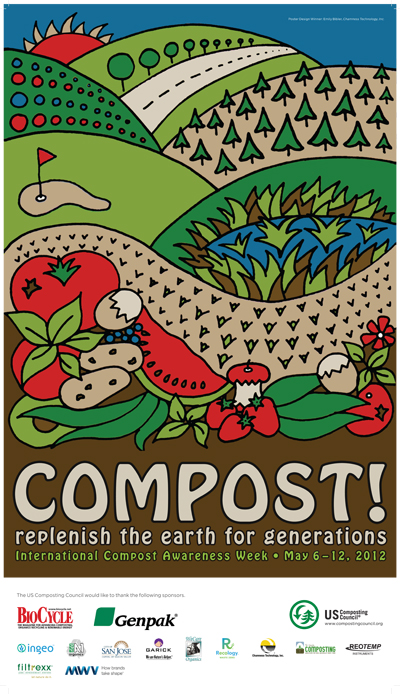Happy International Compost Week!
by Erin Wright, Children’s Garden Educator, Lewis Ginter Botanical Garden
Erin Wright is passionate about food and plants. This post was originally published on Erin’s blog, the Richmond Food Collective.

Whether you pile it, bury it or feed the worms with it, composting is easy and critical to the food system. Talking about waste is not pretty, but it is essential. And trust me, when you see your veggie scraps and yard waste become nutrients for your garden, there is nothing more beautiful!
I am a big believer in composting as an easy way to help minimize trash and to keep your garden growing well. I have seen all kinds of compost systems in my time — three-bin systems, piles housed in chicken wire, buried in holes — even worm bins inside apartment pantries! Personally, I have two piles going right now — a giant one at Lewis Ginter in the Childen’s Garden where I work, and a tiny ‘transfer station’ one at home. Both are super-easy to maintain. (The Garden also has a HUGE compost pile to serve the entire Garden’s needs at an out-of-the-way spot).
The three bin system in Lewis Ginter’s Children’s Garden was initiated by the Garden’s on-site caterer, Meriwether Godsey’s, head chef, Tony Arrington. His dedication to saving food scraps and keeping them in his walk-in refrigerator is essential to the success of the whole operation. Two to three times a week, either the youth volunteers or I head up to the kitchen to collect 6 to 9 five-gallon buckets of salad trimmings and coffee grounds. We incorporate this project into our programs, and visiting families love to help ‘feed the worms’! We cover the food scraps with dried leaves or grass, and add a few handfuls of compost that is farther along in composting to the new pile. When one of those bins fills up, we let it ‘rest’ and let Mother Nature do her work. We take the ‘finished’ compost out of the other bins and adding it to the garden, where we start a new pile. This is a ‘cold composting’ system — it is basically a giant worm bin that never goes above 120 degrees. Sometimes squash seeds will sprout, but we don’t mind.
My pile at home is the super lazy gal’s answer to composting. I have a bucket by the sink for food scraps, and every once in a while, I dump the bucket over the side of my deck. The pile is hidden by a witch hazel shrub from the front. With the small volume I create, even with the garden waste, lint, dog hair and contents of the vacuum bag, it never gets big enough to mess with. Once a year I shovel the stuff from the bottom of the pile onto the garden, but it really just feeds the bed — kind of like a keyhole garden!
So, cheers to you and your compost, whatever form it takes ….and Happy International Compost Week!